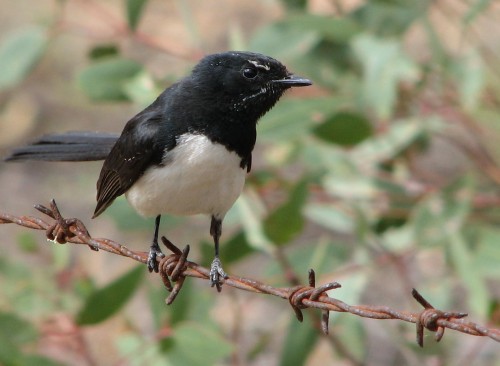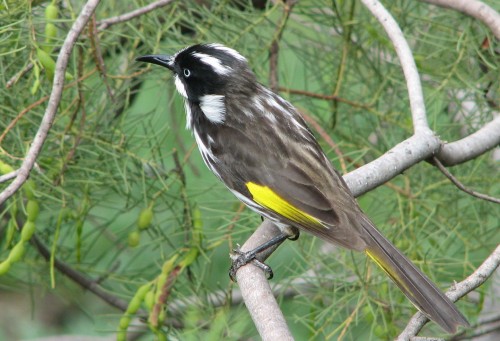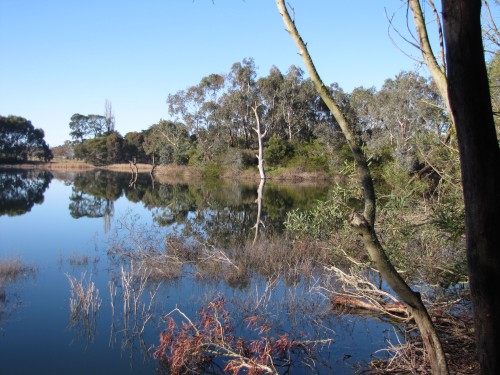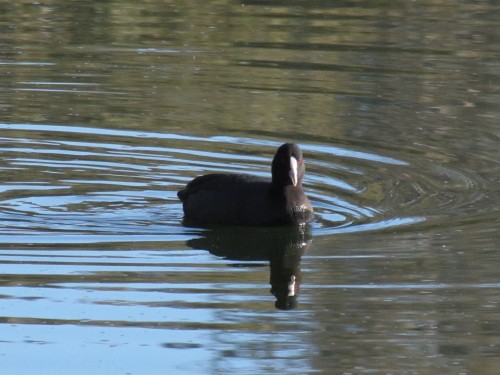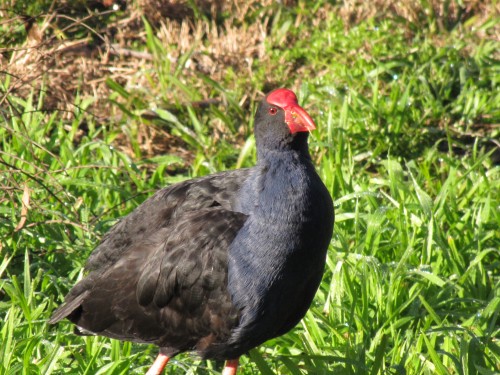Black-Faced Cuckoo-Shrikes
Now back to birding.
While working in the garden over the last few days I have been aware of two Black-Faced Cuckoo-Shrikes visiting the garden from time to time. While not staying in the garden all the time they do seem to be hanging around the general area quite a bit. I wonder if they are actually a pair? Are they looking for a suitable nesting site?
Are they really a “pair”
That reminds me of a birding friend many years ago who gently corrected me on the use of the word “pair” when speaking of birds. I commented that I saw a pair of a particular species (can’t remember which one now). “Did you see them breeding? Were they mating, or feeding young in a nest? If not – your saw two of them, not “a pair.”
Regular Garden Visitor
This beautiful bird is worthy of note in this blog. I could not say that it is a resident species in our garden. It is a regular visitor. In recent months those visits have been quite irregular – until this last week.
Common, Widespread Species
It is a common species and widespread throughout Australia, including Tasmania. In my experience this species is most often encountered singly or in twos. Occasionally I have recorded 3 or 4 together, and once about 8 in a loose flock. According to one field guide I consulted large migratory flocks can be encountered in northern Australia.
Some Habits of Highly Effective Bloggers
Darren Rowse of ProBlogger has challenged his readers to come up with a list of the habits of highly effective bloggers
At first I thought that I didn’t qualify as I had only been blogging seriously for three months. When I thought about it however, I realised I was short changing myself a little. This birding blog started (in another format) nine months ago so I have a reasonable track record already. When I look at my stats I have developed something of a solid reader base with a growing number of hits each day. More and more links are being made and others are starting to ask me for advice! So here goes – for what it’s worth:
Some Habits of Highly Effective Bloggers
1. Effective Bloggers are Content Driven
Far too many blogs – millions of them – are full of drivel, angst and vitriol. Effective bloggers write consistently good content. They make the effort to write readable, interesting and often entertaining content. Their writing is such that it draws the reader back again and again; this builds a loyal readership and that builds consistent traffic. With this birding blog I am aim to share information about Australian Birds with those who are eager to learn about them.
2. Effective Bloggers are Passionate
Write what you are passionate about. I’m passionate about birding, and so are millions of others around the world who want to read about and learn about the beautiful birds we have here in Australia. If you are passionate about your chosen subject you have knowledge to share in abundance, and that makes it easier to find things to write about. Many writing courses and books give the sound advice of “write what you know.” If you know a subject well and you are passionate about it, this will show in your writing. Your writing will resonate an interest in your readers.
3. Effective Bloggers are Persistent
Most things worthwhile cannot be achieved overnight. Effective bloggers are in this for the long haul. They have a long-term view of blogging. I learnt about birds by studying field guides for hundreds of hours. I have spent countless days in the field studying the habits, actions, calls, colours and shapes of birds over a period of nearly thirty years – and I’m still learning. I have read many books, viewed videos and photos, been out birding with experts and attended meetings and conferences about birds. Blogging is no different; persistence is needed in learning all you can about the craft – and then applying what you have learnt.
4. Effective Bloggers are Goal Setters
It seems to me that many effective bloggers have firm goals in mind when they write. Most aim to write often – many do it daily. Most effective bloggers aim to communicate their slant on their subject with passion. Many effective bloggers aim to educate their readers on the nuances of their subject, bringing their unique perspective on the topic. Some just aim to entertain, or inspire, or inform or just have an unshakeable goal to touch the lives of others in a positive way. With this birding blog I always aim to share the delights of the natural world, opening people’s eyes to the amazing beauty out there.
5. Effective Bloggers Research their Subject
Yes – certainly write about what you know, but that is just a starting point. Effective writers know the value of thorough research before committing their thoughts and ideas to print. Bloggers should be no different. Do your research, read what other bloggers in your field are writing about, find blogs to link to, comment on the writings of other bloggers and read, read, read. Warning: read all you can, but don’t forget to write as well. The internet is a dangerous place for the unwary; there are literally millions of distractions lurking out there. I find that looking at the photographs of birds taken by other bloggers to be a terrible distraction from writing. Sometimes I have to take time out and just look at the photos. Sometimes the writing just has to wait!
6. Effective Bloggers are Responsive
An effective method of building a loyal readership and thus traffic to your site is to respond to the comments made by your readers. The flip side of this is that an effective blogger is one who goes out there in their chosen field and comments on the blogs of others, often bringing links back to their own site. This development of a community of readers is a powerful one. I have found this to be true amongst other birders, many of whom are more than willing to link back to my site.
7. Effective Bloggers are Ethical
I believe that the most effective bloggers have an ethical framework for their writing. There is so much garbage out in the blogosphere that it is quite depressing at times, so I don’t bother to read much of it. The other side of a very uneven coin is the growing force of ethical, trustworthy writers who are posting wonderfully entertaining, useful and inspiring pieces every day. Many posts in the birding world are very informative and some are truly beautiful works of art, including thousands of stunning photographs.
These are but a few thoughts on the subject; there must be many more. This post hasn’t turned out quite as I thought it would. So be it.
Back to birding.
That – after all – is what I know best!
Postscript:
I have elaborated on the habits of effective bloggers and writers on my writing blog here.
A summary of the contributions to Darren Rowse’s group writing project can be found here.ÂÂ
Aggressive Bird Behaviour in the Garden
While working in the garden yesterday morning I was suddenly alerted to a noisy confrontation nearby. Our resident Willie Wagtails love to frequent one particular spot where there is an abundance of insects.
Suddenly a New Holland Honeyeater dived in to reap his share of the smorgasbord. The Willie Wagtail became quite aggressive, fanning his tail up high, ruffling the feathers all over and calling in what seemed to me to be in quite an angry – perhaps even distressed – way.
The honeyeater retreated to a nearby tree, only to swoop in repeatedly over the next few minutes. Each time the honeyeater would snap at the Willie Wagtail, zip away a metre or so, grab another insect, and retreat hurriedly to the refuge tree.
These attacks seemed to trigger even more aggression in the Willie Wagtail who decided to front up to the interloper. They then faced each other at about ten paces (bird step size – about 10cm) angrily calling in each others’ face. One last beakful of food and the New Holland Honeyeater decided that other parts of the garden were more attractive anyway, and it flew off. The Willie Wagtail continued to feast contentedly on his little patch.
Further reading:
- Aggressive birds – articles from my archives
This post updated in September 2015.
Darter at Tailem Bend
I recently had a short break for a cuppa on the banks of the River Murray in Tailem Bend, about a twenty minute drive from home in Murray Bridge. While we enjoyed the bright sunshine we were entertained by the passing parade of birds. About 300 Silver Gulls were resting on the lawn area near us. On the river we saw Little Pied and Little Black Cormorants as well as a number of Pacific Black Ducks and Eurasian Coots. A single Australian Pelican could be seen just north of the Ferry crossing the river.
Darter
In the water nearby I observed a Darter, with another one drying its wings on a tree on the river bank. The Darter, also called a Snake Bird, is widespread throughout Australia. It is my observation that it is not common anywhere. I have rarely seen more than two at a time. Its alternative common name, Snake Bird, comes from its appearance when fishing in the water. Unlike many other water birds, the Darter’s body is mostly submerged when it is swimming. With its long, snake-like neck poking above the water as it comes up to breathe, it looks, at first glance, just like a snake swimming along on the surface of the water.
Wing Drying
Like the cormorant family of birds, the Darter must emerge from the water from time to time in order to dry its feathers which are not water resistant. On the occasions when I have been able to approach a Darter drying its wings I have noticed that it waves its long neck around in the manner of a snake. This could be another reason for its other common name.
Other Birds
I also observed a range of other birds in the time we had our picnic. Quite a few Straw-Necked Ibis were feeding on a freshly ploughed paddock directly opposite where we sat. Spotted Turtledoves cooed in the trees nearby and several Magpie-Larks paraded up and down the lawn area near our picnic table. Welcome Swallows constantly swooped low over the water and several Blackbirds searched for tasty morsels in the nearby bushes. I heard the tinkling calls of the Superb Blue Wren in the bushes too, but they didn’t emerge to show off their brilliant colours.
